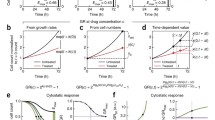Abstract
Cell proliferation assays are an important component of small molecule inhibitor screens for cancer therapies. An important but often overlooked variable involves the timing and timeframe of inhibitor treatment. Whereas many traditional chemotherapeutics kill or inhibit proliferation on the timeframe of hours or in a few days of treatment, more targeted therapies that affect other cancer-relevant pathways, including differentiation or cell stress responses, can take longer, often several days to weeks to impact cellular growth and survival. Many poly(ADP-ribose) polymerases (PARPs) are involved in cellular stress pathways; therefore, phenotypic effects of PARP inhibition are often only observed with long-term inhibitor treatment. Here we summarize several assays for analyzing long-term proliferation of both adherent and suspension cells, relying either on growth in two-dimensional tissue culture or on systems than enable growth in 3D.
Access this chapter
Tax calculation will be finalised at checkout
Purchases are for personal use only
Similar content being viewed by others
References
Kraus WL (2015) PARPs and ADP-ribosylation: 50 years … and counting. Mol Cell 58:902–910. doi:10.1016/j.molcel.2015.06.006
Jones P, Wilcoxen K, Rowley M, Toniatti C (2015) Niraparib: a poly(ADP-ribose) polymerase (PARP) inhibitor for the treatment of tumors with defective homologous recombination. J Med Chem 58:3302–3314. doi:10.1021/jm5018237
Bryant HE, Schultz N, Thomas HD et al (2005) Specific killing of BRCA2-deficient tumours with inhibitors of poly(ADP-ribose) polymerase. Nature 434:913–917. doi:10.1038/nature03443
Farmer H, McCabe N, Lord CJ et al (2005) Targeting the DNA repair defect in BRCA mutant cells as a therapeutic strategy. Nature 434:917–921. doi:10.1038/nature03445
Jones P, Altamura S, Boueres J et al (2009) Discovery of 2-{4-[(3S)-piperidin-3-yl]phenyl}-2H-indazole-7-carboxamide (MK-4827): a novel oral poly(ADP-ribose)polymerase (PARP) inhibitor efficacious in BRCA-1 and -2 mutant tumors. J Med Chem 52:7170–7185. doi:10.1021/jm901188v
Gaymes TJ, Shall S, MacPherson LJ et al (2009) Inhibitors of poly ADP-ribose polymerase (PARP) induce apoptosis of myeloid leukemic cells: potential for therapy of myeloid leukemia and myelodysplastic syndromes. Haematologica 94:638–646. doi:10.3324/haematol.2008.001933
Mukhopadhyay A, Elattar A, Cerbinskaite A et al (2010) Development of a functional assay for homologous recombination status in primary cultures of epithelial ovarian tumor and correlation with sensitivity to poly(ADP-ribose) polymerase inhibitors. Clin Cancer Res 16:2344–2351. doi:10.1158/1078-0432.CCR-09-2758
Lau T, Chan E, Callow M et al (2013) A novel tankyrase small-molecule inhibitor suppresses APC mutation-driven colorectal tumor growth. Cancer Res 73:3132–3144. doi:10.1158/0008-5472.CAN-12-4562
Daigle SR, Olhava EJ, Therkelsen CA et al (2011) Selective killing of mixed lineage leukemia cells by a potent small-molecule DOT1L inhibitor. Cancer Cell 20:53–65. doi:10.1016/j.ccr.2011.06.009
Knutson SK, Wigle TJ, Warholic NM et al (2012) A selective inhibitor of EZH2 blocks H3K27 methylation and kills mutant lymphoma cells. Nat Chem Biol 8:890–896. doi:10.1038/nchembio.1084
Franken NAP, Rodermond HM, Stap J et al (2007) Clonogenic assay of cells in vitro. Nat Protoc 1:2315–2319. doi:10.1038/nprot.2006.339
Author information
Authors and Affiliations
Corresponding author
Editor information
Editors and Affiliations
Rights and permissions
Copyright information
© 2017 Springer Science+Business Media LLC
About this protocol
Cite this protocol
Keilhack, H., Chang, P. (2017). In Vitro Long-Term Proliferation Assays to Study Antiproliferative Effects of PARP Inhibitors on Cancer Cells. In: Tulin, A. (eds) Poly(ADP-Ribose) Polymerase. Methods in Molecular Biology, vol 1608. Humana Press, New York, NY. https://doi.org/10.1007/978-1-4939-6993-7_21
Download citation
DOI: https://doi.org/10.1007/978-1-4939-6993-7_21
Published:
Publisher Name: Humana Press, New York, NY
Print ISBN: 978-1-4939-6992-0
Online ISBN: 978-1-4939-6993-7
eBook Packages: Springer Protocols




